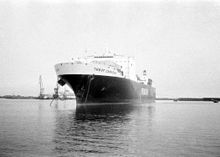Yulius Fuchik
|
||||||||||||||||||
|
||||||||||||||||||
|
||||||||||||||||||
|
||||||||||||||||||
|
||||||||||||||||||
|
||||||||||||||||||
The Yulius Fuchik ( Russian Юлиус Фучик , German transcription Julius Fučík - after the Czech author) was a Soviet variant of the US SeaBee ship .
prehistory
In the 1960s, the American shipbuilding engineer Jerome L. Goldman developed the LASH system and founded the Lighter Aboard Ship Corporation to market the patented system . The background to the development was the very long port lay times that were customary at the time, which should be shortened with the high throughput of the LASH system of over 1000 tons per hour. In 1969 and 1970 the first LASH ships, Acadia Forest and Atlantic Forest , entered service. About 20 more units followed according to the LASH principle.
The shipping company Lykes Lines from New Orleans pursued a slightly different concept of a light ship and created the design for the SeaBee ship together with the shipbuilding office JJ Henry & Company from New York . In contrast to the LASH ship, larger barges are used, which are lifted in pairs on deck with an elevator (a kind of lift) and placed on an internal sliding system. Lykes built a series of three Seabee ships of the MARAD design C8-S-82a in 1972/73 .
history

In 1974 the Soviet Union approached the Finnish Valmet shipyard with a development contract for a light ship design. On the basis of the preliminary considerations, the Soviet ships should also be usable for military purposes and transport lighter, the dimensions of which were intended for use as far as the Rhine-Main-Danube Canal . The so-called Danube-See-Lighter or DM-Lighter were at 38.25 meters exactly half as long as the Europa-II or Danube push barges. They were 11.40 meters wide and with a side height of 3.90 meters and a draft of 3.22 meters had a load capacity of up to 1070 tons each.
Valmet, with the knowledge and approval of the US government, acquired the necessary license rights to build two ships based on the SeaBee principle. At the end of 1979 the sister ship Tibor Szamuely was added to the Yulius Fuchik , which was put into service at the end of 1978 . The ships could carry up to 26 of the standardized DM lighters or 54 LASH lighters as well as additional RoRo cargo or containers. Around two barges were handled every hour.
On May 18, 1978, the USSR, Bulgaria, Hungary and Czechoslovakia founded the joint shipping company Interlighter in Izmail . Interlighter partners were the Hungarian shipping company Mahart and the Soviet and Czechoslovak Danube shipping companies. Interlighter chartered the two ships long-term from the Soviet Danube shipping company. The Yulius Fuchik was used from December 8, 1978 in the Danube Sea Line service on the route from the Danube Delta to Karachi and Bombay. After the sister ship Tibor Szamuely had also been delivered on November 2, 1979 , the service was expanded to include ports of call in Vietnam , Kampuchea and Malaysia .
In Europe, the barges picked up their cargo in the entire Danube region, sometimes as far as Regensburg . After about 18 days of sea voyage, the ports of call in Asia were reached with Ho Chi Minh City on the Mekong Delta as the main port, from where the barges went to Phnom Penh . Trips to Karachi , Bombay and Penang took correspondingly longer. The round trips were originally designed for 33 and 46 days. Long anchor times in Vietnam, during which the barge was hauled and the cargo handled, however, occasionally extended the duration of the voyage to up to three months. In the early 1990s the load on the service dropped, whereupon both ships were hung up. In 1998 and in the following years the ships were passed on several times. In 2003 they finally arrived in Alang and Gadani Beach for scrapping .
In popular culture
In the novel Im Sturm by Tom Clancy , the ship Julius Fucik (as it is spelled there) serves to transport a division of Soviet paratroopers to Iceland as undiscovered as possible. The ship poses as one of the Lykes Lines and was redesigned accordingly beforehand.
The ships
| Overview | |||||
|---|---|---|---|---|---|
| Building name | Build number | IMO number | delivery | Later names and whereabouts | |
| Yulius Fuchik | 290 | 7505322 | October 20, 1978 | 1998 Production Driller , 2002 Asian Alliance , 2003 Alliance , in July 2003 for demolition in Alang | |
| Tibor Szamueli | 291 | 7505334 | 2nd November 1979 | 1998 Development Driller , 2002 Asian Reliance , 2003 Reliance , 2003 C Reliance , in October 2003 for demolition in Gadani Beach | |
| Data: Equasis, large tonnage | |||||
literature
- Günter Hähnel: Lighter carrier JULIUS FUČIK in the yearbook of shipping 1981, Berlin, 1980, p. 88/89
- Hans Jürgen Witthöft: Piggyback across the sea. The barge carrier family . Koehlers Verlagsgesellschaft, Hamburg 1987, ISBN 3-7822-0275-9 .
- Register Book of seagoing Ships 1982, USSR Register of Shipping
- Register of Ships 1982/83, Lloyd's Register of Shipping, London
Individual evidence
- ↑ Equasis homepage (English)
- ↑ grosstonnage homepage (English)
